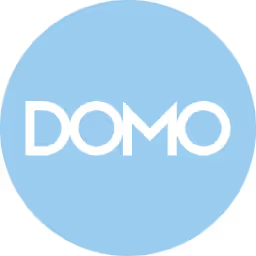Qwilr Alternatives
Compare 10 Qwilr alternatives. An in-depth look at features, pricing, and performance to help you choose the right replacement.

You might use Qwilr to create and track proposals, and for good reason. The tool is great for interactive documents and gives you helpful analytics on client engagement. It performs well for its core functions.
Still, some users find the design options can be limited and the pricing tiers complex. This might lead you to look for a different fit. We've analyzed the top alternatives to help you find the right tool for your team. Let's get started.
Try 11x for Your Sales Team
If your sales process could benefit from digital workers, consider 11x. The platform uses specialized agents to automate sales tasks. This may be a good fit if you want to add automation to your sales operations.
11x is a go-to-market platform that uses AI agents to manage the sales process.
Its AI agent, Alice, finds prospects, handles outreach through email and LinkedIn, and updates your CRM. A second agent, Julian, qualifies inbound leads and schedules meetings.
The platform unifies functions for data enrichment, sales outreach, and email warmup, which removes the need for separate point solutions.
Qwilr Alternatives
Here is a detailed review of the top alternatives to Qwilr. Each review covers pricing and main features, along with potential advantages and drawbacks compared to Qwilr.
1) PandaDoc

PandaDoc is a platform for end-to-end agreement management. It allows users to create interactive sales proposals and track how recipients engage with them. The tool also handles business documents like quotes, contracts, and invoices.
Its workflow spans document generation through eSignature and payment collection. The platform supports contract lifecycle management and provides digital deal rooms for collaboration. It is a cloud-based system for a variety of business agreements.
PandaDoc's Main Features
The platform includes a configure-price-quote tool that pulls data from a product catalog to generate automated quotes with specific pricing rules.
It provides legally binding eSignatures with options for signing order, signer identity verification, and notarization.
Users can embed payment gateways like Stripe, PayPal, or Square directly into documents for immediate payment collection.
The tool offers digital deal rooms that function as collaboration spaces for real-time commenting, redlining, and approvals.
How PandaDoc Compares to Qwilr
Average Review Score: 4.7/5 stars based on 2,893 G2 reviews
PandaDoc offers advanced eSignature options like identity verification and notarization. This provides more security for legal documents than Qwilr's standard signature feature.
The tool manages the entire contract lifecycle, from creation to renewal. This is a broader scope than Qwilr, which focuses mainly on the proposal stage.
It includes a configure-price-quote (CPQ) tool that generates automated quotes from a product catalog. This helps sales teams create complex pricing, a function not central to Qwilr.
The platform provides digital deal rooms for real-time collaboration. These spaces let teams and clients comment and redline documents together, which makes the negotiation process more interactive.
PandaDoc's Drawbacks Compared to Qwilr
PandaDoc has more limited design options than Qwilr. This can be a drawback for teams that need to create highly stylized, interactive web proposals, which is Qwilr's specialty.
Its focus on the full document lifecycle means proposal features can feel less specialized than Qwilr's. Qwilr is purpose-built for sales proposals and offers more detailed engagement analytics.
Some users report occasional bugs or signature issues, which can disrupt workflows. In comparison, Qwilr is often noted for its smooth user experience in document creation and viewing.
Cost and Plan Comparison
PandaDoc offers an Essentials plan at $19 per seat per month and a Business plan at $49 per seat per month. This per-seat model provides a clear cost structure, which can be more straightforward than Qwilr's pricing tiers. PandaDoc may offer more predictable costs for growing teams, while Qwilr's model could be better for specific, custom needs.
2) Proposify
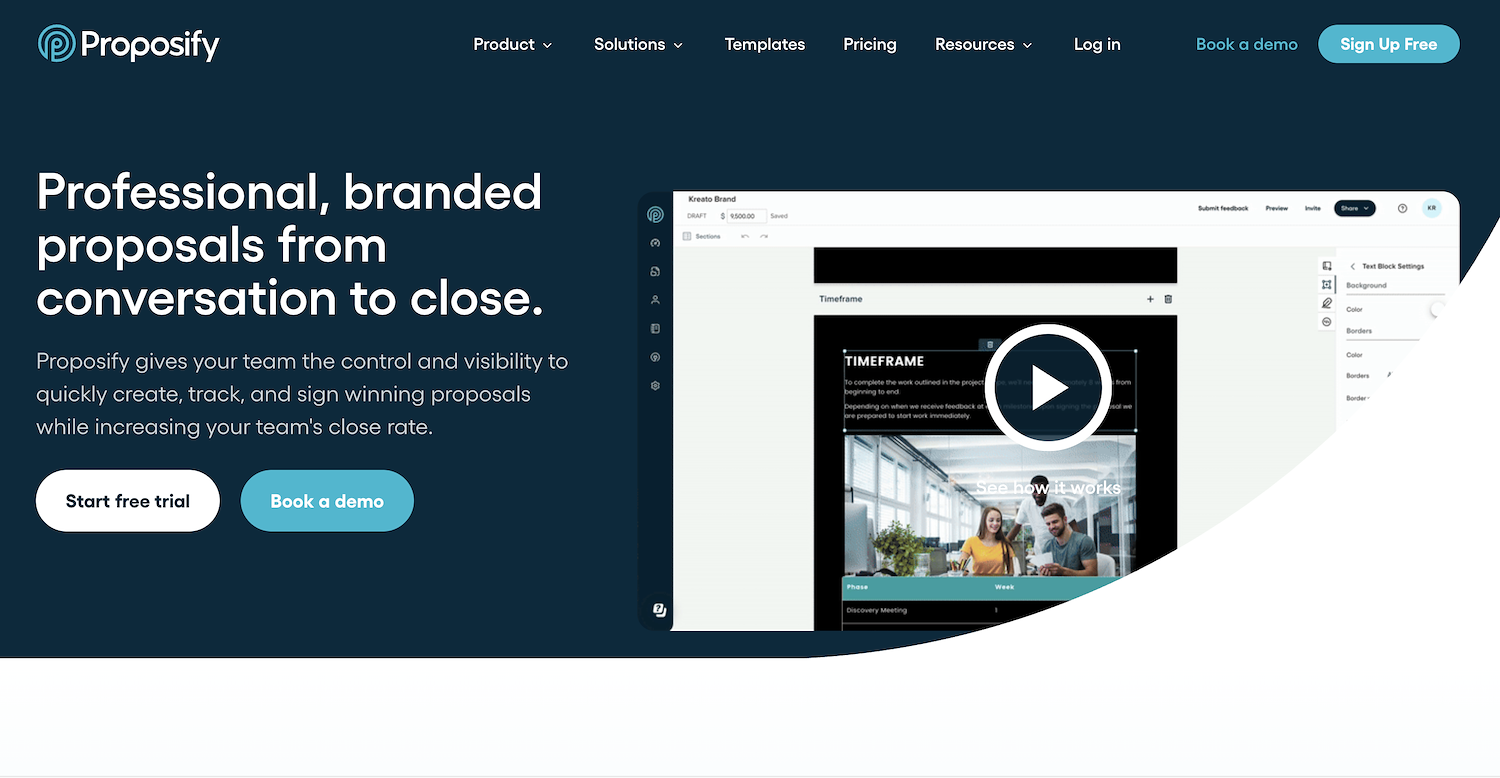
Proposify is a cloud-based platform for revenue teams to create, send, and track business documents. It handles proposals, quotes, and contracts with e-signature capabilities. The tool gives organizations central control over their documents and real-time visibility into client engagement.
Use cases include sales proposals, statements of work, and interactive quotes. The system supports workflows for contracts and agreements and helps manage responses to RFPs and bids.
Proposify's Main Features
The platform offers automated workflows that include AI-assisted writing, approval rules, and triggers based on deal size or discounts.
It provides interactive quoting, which allows prospects to adjust quantities and select add-ons directly within the document.
The system includes roles and permissions, content locking, and custom variables for merging data from a CRM.
Users can create custom domains for white-labeled proposal URLs to maintain brand consistency.
How Proposify Compares to Qwilr
Average Review Score: 4.6/5 stars based on 1,122 G2 reviews
Proposify includes approval workflows that let managers review documents before they are sent. This adds a layer of control not central to Qwilr's creation process.
The tool offers content locking and centralized management for brand assets. This helps maintain consistency across proposals, a different approach from Qwilr's focus on flexible design.
It provides interactive quoting where clients can adjust options and quantities themselves. This is a more dynamic pricing feature compared to the static pricing blocks often used in Qwilr.
The platform supports detailed user roles and permissions. This gives managers specific control over who can create and approve documents and provides a different level of administrative oversight than Qwilr.
Proposify's Drawbacks Compared to Qwilr
Some users find Proposify's document editor less intuitive than Qwilr's. This can sometimes cause formatting problems and makes it difficult to achieve a specific design without extra effort.
The tool's proposals are less like interactive web pages compared to Qwilr. Qwilr allows for more dynamic embedded content, which can create a more interactive experience for the client.
Its analytics on client engagement can feel less detailed than Qwilr's. Qwilr specializes in how clients interact with each proposal section and offers deeper insights that some users might miss.
Cost and Plan Comparison
Proposify's Team plan costs $41 per user per month, while its Business plan is $65 per user per month. This per-seat pricing can be more predictable than Qwilr's complex tiers, making it a straightforward choice for teams that need to manage costs as they scale.
3) Better Proposals
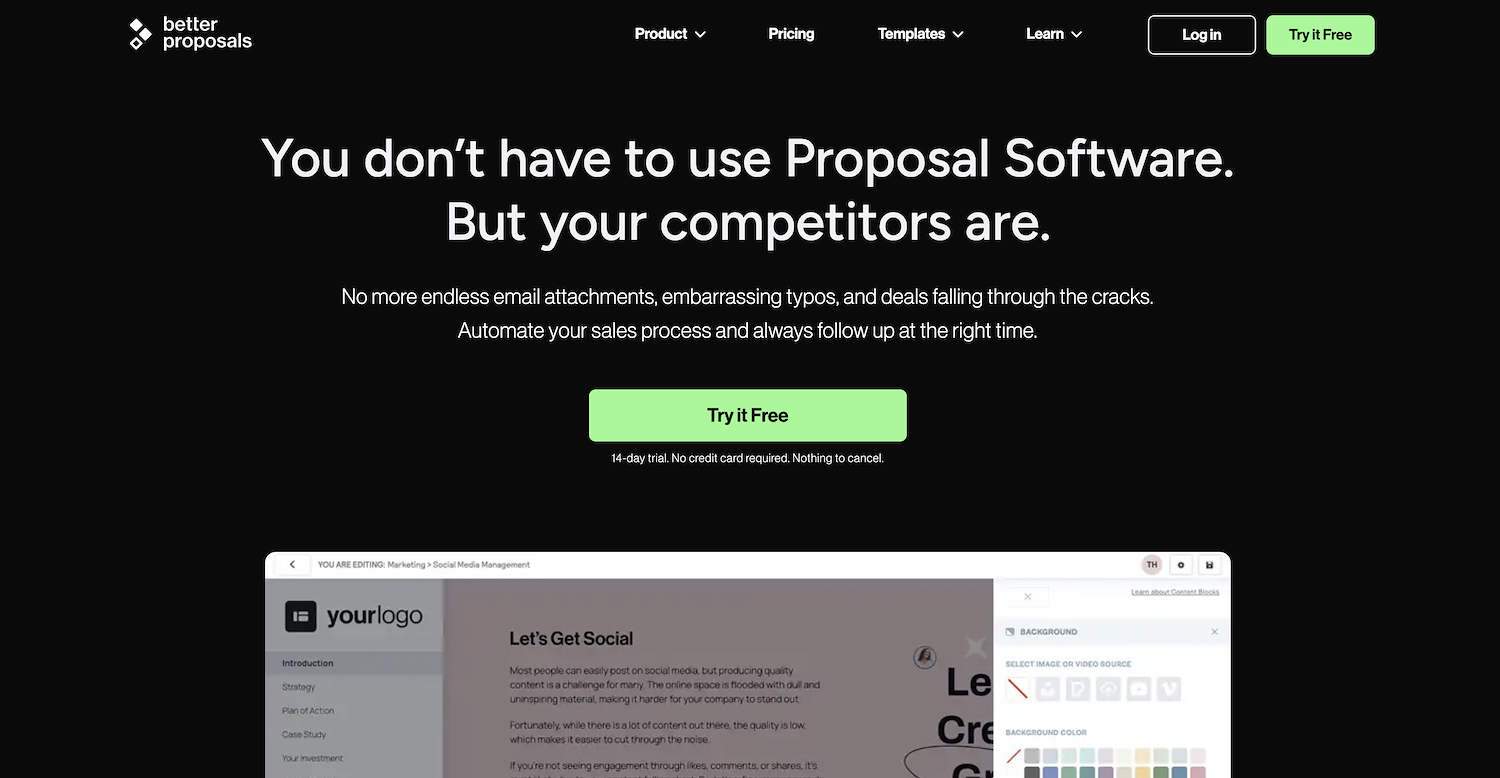
Better Proposals is a cloud platform to create, send, and track documents. It replaces tools like Word and PDFs. The system manages the document process from start to signature and client onboard steps.
Common uses are interactive proposals for any device, legally valid contracts, and job offers. The platform also supports sales team document management and tracks prospect engagement.
Better Proposals's Main Features
The platform provides post-signature workflows to collect payments, schedule calls, and gather client information.
It includes a library of over 260 templates and allows users to import existing Word documents.
The service offers 24/7 live human support with an average response time of two minutes.
Documents are sent as web links and include features like built-in live chat and optional upsell add-ons.
How Better Proposals Compares to Qwilr
Average Review Score: 4.3/5 stars based on 48 G2 reviews
Better Proposals offers post-signature workflows for payment collection and client onboarding. This extends the process beyond Qwilr's focus, which is primarily on document creation and the signature stage.
It provides a library of over 260 pre-made templates. This gives users more ready-to-use options compared to Qwilr, where the emphasis is on the creation of custom, interactive pages from a blank slate.
The platform includes built-in live chat within documents. This feature allows for real-time client communication directly on the proposal, a different approach from Qwilr's focus on engagement analytics.
This tool offers 24/7 live human support. This provides a level of immediate assistance that is distinct from the standard support channels available for Qwilr users.
Better Proposals's Drawbacks Compared to Qwilr
Better Proposals offers less design flexibility than Qwilr. Its proposals are more structured, which can feel restrictive compared to Qwilr's ability to build documents that look and feel like custom web pages. This might limit creative branding opportunities.
The tool's analytics on client engagement can be less detailed than Qwilr's. It provides general tracking, but some teams might miss the granular, section-by-section insights on viewer interaction that Qwilr offers for optimizing content.
Some users report that the document editor can feel less intuitive than Qwilr's. This may occasionally lead to formatting challenges. In contrast, Qwilr is often noted for its smooth, block-based editor that simplifies the creation of complex layouts.
Cost and Plan Comparison
Better Proposals offers plans at $19, $49, and $129 per month, providing a predictable cost structure. This contrasts with Qwilr's more complex pricing tiers, making Better Proposals a straightforward option for teams that need clear budgeting. For the most current details, check Better Proposals's official website.
4) GetAccept

GetAccept is a digital sales room platform for revenue teams. It combines document management, e-signatures, and buyer engagement tools. The system lets users create, send, and track sales documents across the deal lifecycle, from initial contact to a signed contract.
Its main use cases are sales proposals and contract management. The platform also provides deal rooms for prospect engagement and negotiation.
GetAccept's Main Features
The platform provides a digital sales room, which is a shared microsite that houses all deal collateral from the first call to the final signature.
It includes mutual action plans, which are interactive closing plans shared with buyers to align on next steps in the deal process.
The system offers sales engagement tools like in-document chat, video messages, and automated reminders to facilitate communication.
It manages contracts with a central repository that includes version control, status visibility, and renewal reminders.
How GetAccept Compares to Qwilr
Average Review Score: 4.6/5 stars based on 1,023 G2 reviews
GetAccept provides a digital sales room, a shared space for all deal collateral. This differs from Qwilr, which centers on the individual proposal document.
The platform includes mutual action plans that help align buyers and sellers on next steps. This is a more collaborative approach compared to Qwilr's focus on tracking proposal engagement.
It offers contract management with version control and renewal reminders. This expands its function beyond the proposal stage, which is Qwilr's primary focus.
The tool integrates sales engagement features like video messages and live chat. This allows for direct communication within the document, a different method than Qwilr's analytics-based engagement tracking.
GetAccept's Drawbacks Compared to Qwilr
GetAccept provides less design flexibility. Its editor is more structured, which some users find limits the ability to create the unique, web-page-style proposals possible with Qwilr.
Its analytics focus on the overall deal lifecycle. This approach differs from Qwilr, which provides granular, section-by-section data on how clients engage with the proposal content.
The platform's broad focus on the entire sales process can make its proposal tools feel less specialized. In contrast, Qwilr is purpose-built for interactive proposals and has a more dedicated feature set for that task.
Cost and Plan Comparison
GetAccept offers an E-sign plan at $25 per user per month and a Professional plan at $49 per user per month. This per-seat model provides a predictable cost structure, which can be more straightforward than Qwilr's complex pricing tiers.
5) DocSend
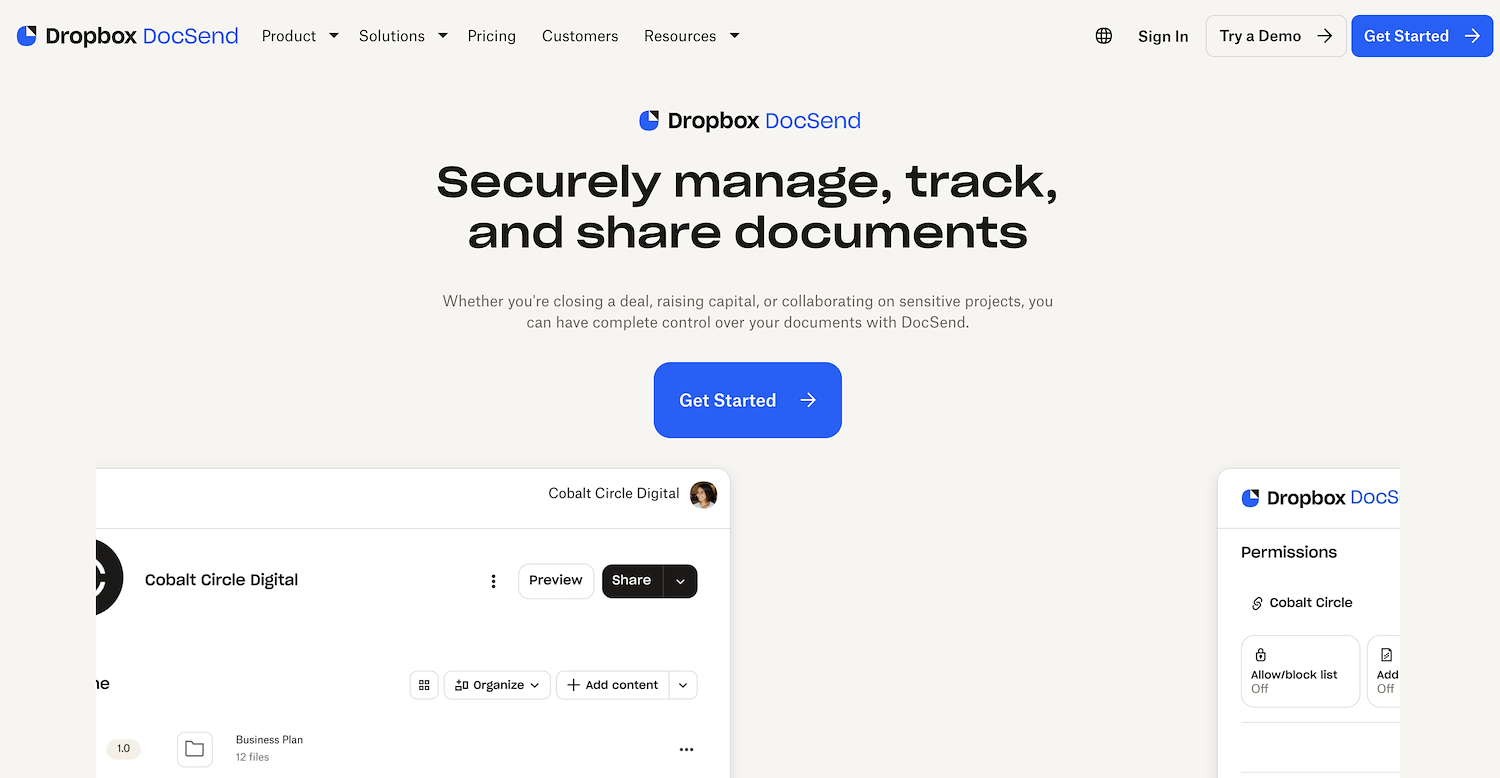
DocSend is a platform for secure document delivery and analysis. It gives users control over business materials after they are sent. The system provides real-time, page-by-page data on document engagement.
Common uses are sales collateral, investor pitches, and business proposals. The platform helps users gauge viewer interest and protect sensitive information through access controls and email verification.
DocSend's Main Features
The platform offers virtual data rooms for due diligence and pitching, allowing links to be updated without disrupting viewers.
It provides advanced security features, including one-click NDAs, dynamic watermarking, and granular permissioning.
The system delivers real-time, page-level analytics for documents and videos, along with view notifications.
Users can send a single, trackable link instead of attachments and can revoke or update content at any time.
How DocSend Compares to Qwilr
Average Review Score: 4.6/5 stars based on 529 G2 reviews
DocSend provides advanced security controls like one-click NDAs and dynamic watermarking. This offers more protection for sensitive documents compared to Qwilr's standard document sharing.
It delivers page-by-page analytics that show who viewed a document and for how long. This provides a different kind of insight than Qwilr's analytics, which focus on interaction with specific proposal elements.
The tool includes virtual data rooms to manage multiple documents for complex deals, such as fundraising. This function is different from Qwilr, which centers on creating single, interactive proposals.
Users can securely send and track existing documents like PDFs or presentations with DocSend. This contrasts with Qwilr, which is a tool for building new, interactive documents from scratch within its editor.
DocSend's Drawbacks Compared to Qwilr
DocSend lacks a native document editor for creating proposals from scratch. In contrast, Qwilr provides a block-based editor that allows users to build custom, interactive documents directly on the platform.
The tool does not allow for the creation of interactive proposals that function like web pages. This can be a limitation for teams that want to embed dynamic content, which is a core feature of Qwilr.
It does not have an integrated e-signature function as a central part of its workflow. This is different from Qwilr, where collecting signatures is a key step in the proposal process.
Cost and Plan Comparison
DocSend offers plans starting from $10 per user per month for its Personal plan and $45 for its Standard plan. This per-seat model provides a predictable cost structure, which can be more straightforward than Qwilr's complex pricing tiers.
Consider 11x for Sales Automation
For teams interested in adding digital workers to their sales process, 11x presents a focused solution. Its AI agents manage prospecting, outreach, and lead qualification. If your goal is to automate these specific sales functions, exploring 11x could be a logical next step.
With 11x, our AI manages your sales playbook. Alice identifies target accounts and runs outreach, while Julian qualifies inbound prospects and schedules meetings. We combine functions like data enrichment and email warmup into one platform, replacing other tools in your stack.
Book a demo to see the platform in action.
6) Nusii
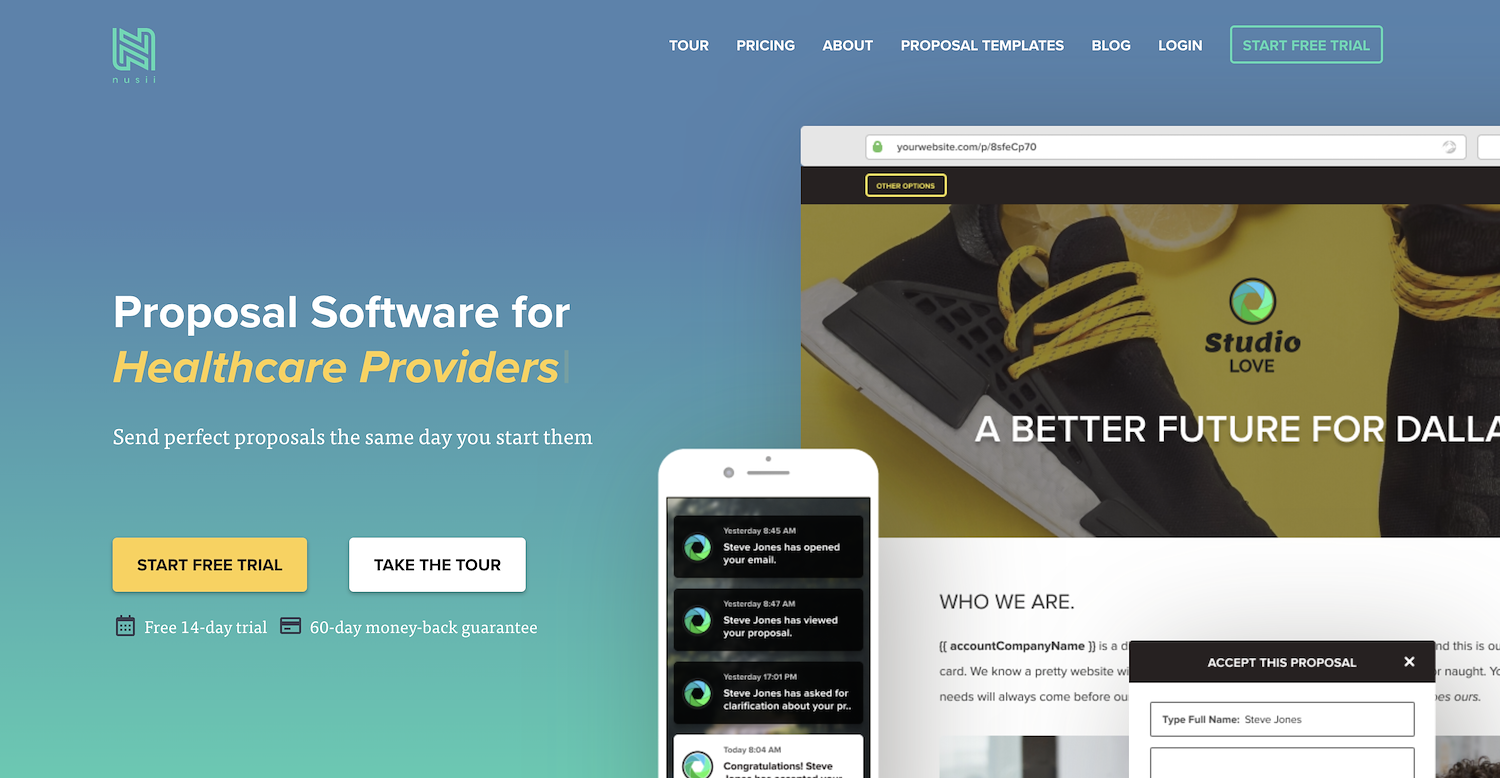
Nusii is proposal software that helps teams create and send business documents. The platform manages the proposal process from creation to tracking. Common use cases include online proposals and sales documents that require client engagement analytics.
Nusii's Main Features
The system saves reusable content sections and pricing tables, and uses dynamic variables to automatically insert client-specific data.
It sends real-time notifications when a client opens or views a proposal and provides automated nudges for follow-ups on unopened documents.
Users can apply custom branding with their own logo and colors and send proposals from a custom domain and email address.
The software connects with CRMs like HubSpot and Pipedrive through native or Zapier integrations and includes a public REST API for custom workflows.
How Nusii Compares to Qwilr
Average Review Score: 4.5/5 stars based on 24 G2 reviews
Nusii allows users to save and reuse content sections. This approach can save time compared to Qwilr, which focuses on creating custom proposals from individual blocks.
The tool sends automated follow-up reminders for unopened proposals. This is a different notification feature from Qwilr's, which provides analytics on how clients interact with an opened document.
It supports custom branding by letting users send proposals from their own domain and email address. This offers a different level of brand control compared to Qwilr's standard proposal links.
The platform provides a public REST API to build custom workflows. This gives teams more technical flexibility for integrations than Qwilr, which relies on its standard connections.
Nusii's Drawbacks Compared to Qwilr
Nusii offers less design flexibility than Qwilr. Some users report that the formatting controls are limited, which can make it difficult to create the highly custom, web-page-like proposals that are a core feature of Qwilr.
The platform's analytics can feel less detailed. It tracks general engagement but may not offer the same granular, section-by-section insights on client interaction that Qwilr provides for content optimization.
It lacks a built-in payment integration. This is different from Qwilr, where users can embed payment gateways directly into a proposal. With Nusii, payment collection is a separate process that happens outside of the document.
Cost and Plan Comparison
Nusii offers plans at $29, $49, and $129 per month. This tiered model provides a predictable cost structure, which can be more straightforward for budgeting than Qwilr's more complex pricing.
7) Quotient
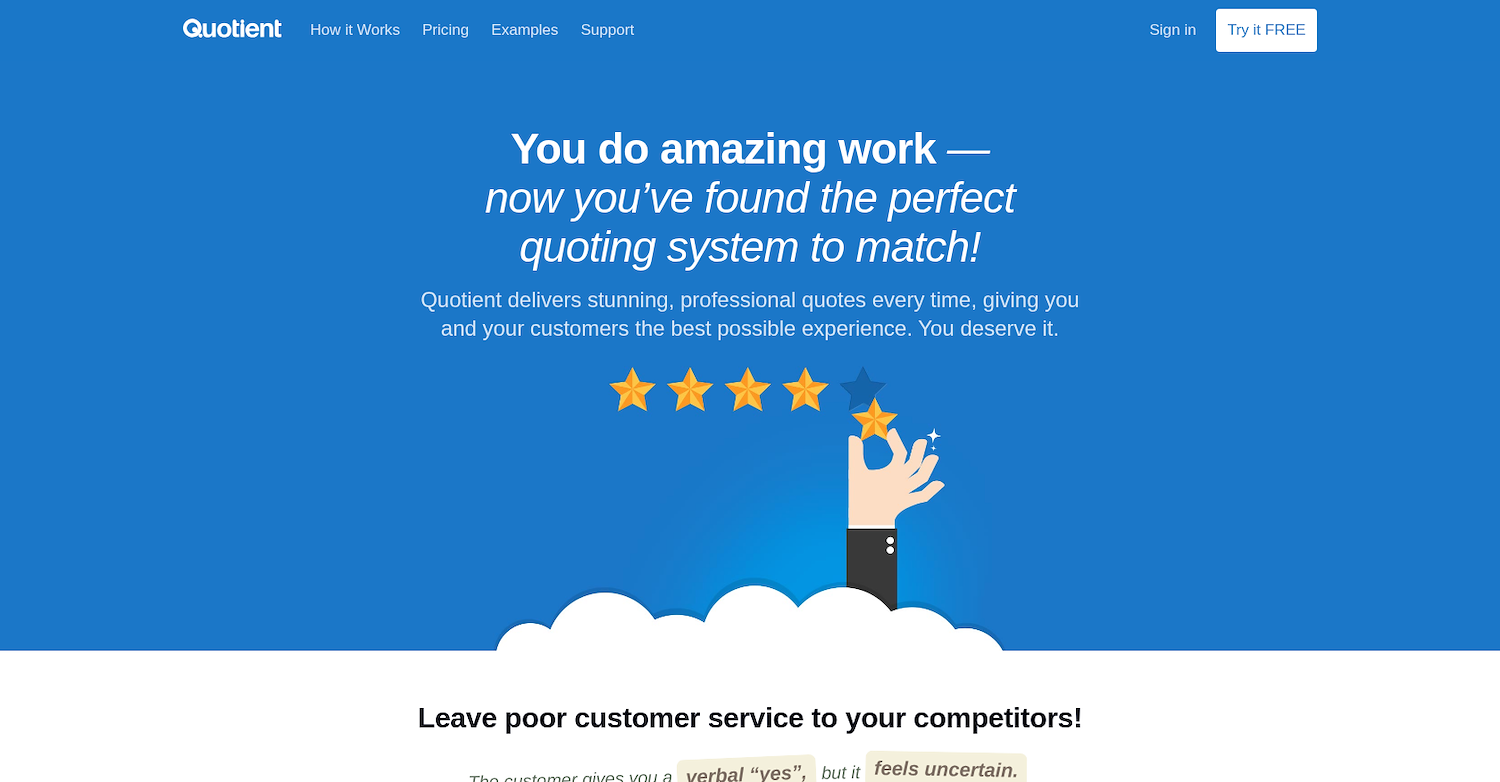
Quotient is online software to create, send, and manage quotes. The platform allows customers to accept quotes online from any device. It is a tool for businesses that need a direct way to handle the quote process and track document status.
Quotient's Main Features
Lets customers ask questions directly on the quote, which keeps communication in one place.
Presents optional and multiple-choice items to show upsells or package variations in a single quote.
Schedules automated reminders to follow up with prospects who have not responded.
Collects customer reviews automatically after a job is complete.
How Quotient Compares to Qwilr
Average Review Score: 4.7/5 stars based on 21 G2 reviews
Quotient allows customers to ask questions directly on the quote, which keeps all communication in one place. This is different from Qwilr, where communication typically happens outside the document.
The tool presents optional and multiple-choice items, which lets clients choose from different packages or upsells in one quote. This provides more flexibility than Qwilr's standard pricing blocks.
It schedules automated reminders to follow up on quotes that have not been opened. This is a proactive feature, while Qwilr's analytics focus on engagement after a client views the document.
Quotient automatically collects customer reviews after a job is finished. This extends the workflow beyond the proposal stage, a function not present in Qwilr.
Quotient's Limitations Compared To Qwilr
Quotient's design capabilities are more structured around quotes. This may limit the creation of highly custom, interactive proposals. In comparison, Qwilr functions more like a web page builder, which offers greater creative control over the final document's appearance.
The tool provides general analytics on quote views. Some teams might miss the detailed, section-by-section engagement data that Qwilr offers. This granular insight helps users understand which parts of a proposal are most effective.
It does not include a built-in payment gateway. This is different from Qwilr, where clients can pay directly from the proposal. With Quotient, payment collection is a separate step that often happens after the quote is accepted, for example, through a Xero invoice.
Cost and Plan Comparison
Quotient offers a Solo plan at $28 per month and a Team plan at $48 per month. This simple tiered structure provides a more predictable cost model compared to Qwilr's complex pricing, which can be beneficial for budgeting.
8) Canva

Canva is a visual communication platform to create various types of content. Teams use it for documents, presentations, and other brand assets. Its application includes business proposals and reports, which makes it a tool for sales and marketing departments.
The platform offers a large template library and a drag-and-drop editor. These features help users produce visual materials without extensive design experience. It also supports brand kits for consistent visuals.
Canva's Main Features
The platform provides a drag-and-drop editor and a stock library with images, videos, and fonts.
Users can create designs from templates and export them as different file types.
It includes features for ad management, which allows users to create and schedule content.
The system offers a dashboard for performance tracking and monitoring template usage.
How Canva Compares to Qwilr
Average Review Score: 4.7/5 stars based on 5,437 G2 reviews
Canva provides design tools for a wide range of visual content, including presentations and social media graphics. This scope is broader than Qwilr's, which focuses on building interactive proposals.
The platform includes a large stock library with images, videos, and fonts. This gives users more built-in assets for design compared to Qwilr, which centers on custom block-based creation.
Users can export their creations into various file types like PDFs and images. This offers more format flexibility than Qwilr, which primarily delivers content as an interactive web page.
The system offers brand kits to manage logos, colors, and fonts for consistent visuals across all documents. This is a more comprehensive brand management feature than the styling options available for individual proposals in Qwilr.
Canva's Drawbacks Compared to Qwilr
Canva does not offer detailed engagement analytics for proposals. In comparison, Qwilr provides section-by-section data on how a client interacts with a document, which helps to see which parts of a proposal are most effective.
The platform lacks a native e-signature function. This is different from Qwilr, where collecting a signature is an integrated step. Users may need a separate tool to finalize agreements made in Canva.
It is not designed to create interactive proposals that function like web pages. Qwilr allows for dynamic content and pricing blocks, while some teams might find Canva's static output less engaging for clients.
The tool does not support built-in payment gateways. With Qwilr, a client can accept a proposal and pay directly within the document. This feature is absent in Canva, which requires a separate process for payment collection.
Cost and Plan Comparison
Canva offers a free plan and predictable per-user pricing starting at $15 per month, making it a straightforward option for budgeting. This contrasts with Qwilr's complex pricing tiers, which may be less predictable but could be better suited for teams with custom requirements.
9) Clientary

Clientary is a business management platform for freelancers and small agencies. The system combines proposals, invoices, and client management. Users create estimates and proposals, then convert them to invoices after client approval.
The tool also supports time logs and project management for a full view of client work from start to finish.
Clientary's Main Features
The system includes time tracking, which allows users to log hours against specific projects and tasks.
It handles client invoicing, with functions for creating and delivering invoices to clients.
The platform supports document customization through the use of variables and custom fields.
It provides a branded client portal for professional interaction with clients and prospects.
How Clientary Compares to Qwilr
Average Review Score: 4.7/5 stars based on 45 G2 reviews
Clientary includes a time log function to record hours against projects. This is a feature not found in Qwilr, which focuses on proposal creation.
The tool converts approved proposals directly into invoices. This differs from Qwilr, where payment collection is an embedded feature but the creation of a full invoice is a separate step.
It provides a branded client portal for all client interactions. This offers a more centralized space for communication compared to Qwilr's individual proposal links.
This platform manages the full client lifecycle, from proposals to project management and payments. This is a broader scope than Qwilr, which is specialized for the sales proposal stage.
Clientary's Drawbacks Compared To Qwilr
Clientary offers less design flexibility for proposals. Its documents are more structured, which can feel limiting compared to Qwilr's block-based editor that builds interactive web pages.
The tool provides general document tracking. Some teams might miss the detailed, section-by-section engagement analytics that Qwilr offers to show which content performs best.
It does not have a built-in payment gateway within the proposal itself. This is different from Qwilr, where clients can accept and pay directly from the document, which can shorten the sales cycle.
Cost and Plan Structure
Clientary offers plans at $19, $39, and $59 per month. This tiered model provides a predictable cost structure, which can be more straightforward for budgeting than Qwilr's more complex pricing.
10) Visme
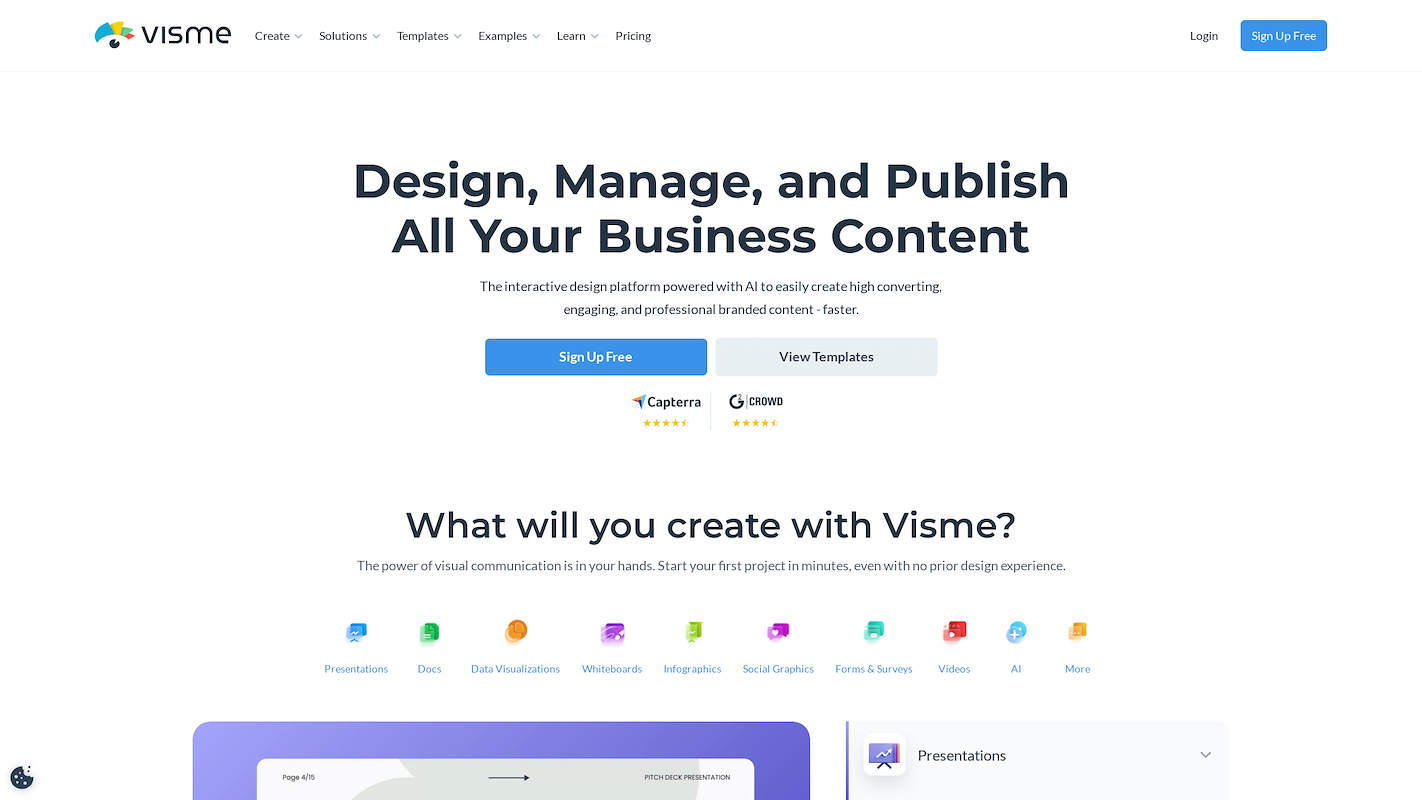
Visme is a platform to create and manage visual content. Teams use it to produce documents, presentations, and data visualizations. Its application includes business proposals and reports, which makes it a tool for sales and marketing departments.
The system allows users to share content through a link and analyze viewer engagement. It is for teams that need to present information and data in a visual format.
Visme's Main Features
Provides tools for data visualization, including graphs, charts, and reports.
Includes a template library and an AI generator that creates designs from text prompts.
Offers presenter tools and slide design features for creating and delivering presentations.
Allows for the creation of animated web forms and interactive infographics.
How Visme Compares to Qwilr
Average Review Score: 4.5/5 stars based on 448 G2 reviews.
Visme provides data visualization tools to create graphs and charts. This is different from Qwilr, which focuses on proposal layout rather than complex data presentation.
The platform includes an AI generator to create designs from text prompts. This offers a different starting point for content creation compared to Qwilr's manual block-based system.
It creates a wider range of content, such as interactive infographics and animated forms. Qwilr, in contrast, specializes in building interactive sales proposals.
This tool offers presenter tools for live slide presentations. This function supports a different use case than Qwilr, which delivers proposals as self-guided web pages.
Visme's Drawbacks Compared To Qwilr
The platform's analytics may feel general to some users. This is different from Qwilr, which provides detailed, section-by-section data on how a client engages with a proposal, offering deeper insights for content optimization.
Visme does not include an integrated e-signature workflow. In contrast, Qwilr builds this function directly into the proposal process, which can remove the need for a separate signing tool to finalize an agreement.
It lacks a built-in payment collection feature within its documents. Qwilr allows clients to pay directly from an accepted proposal, which can help shorten the sales cycle by combining acceptance and payment into one step.
Creating proposals that feel like interactive web pages can be a challenge. Qwilr's block-based editor is specifically designed for this purpose, allowing for more dynamic layouts than what might be possible with Visme's more presentation-focused tools.
Cost and Plan Comparison
Visme offers a free plan, a Personal plan at $12.25 per month, and a Business plan at $24.75 per month. This clear, per-user pricing provides a predictable cost structure, which can be more straightforward than Qwilr's complex pricing tiers.
Which One Should You Go With?
Many variables factor into choosing a Qwilr alternative, from design needs to budget. This guide reviewed several options to help you find the right fit for your team.
If your goal is to automate sales functions, 11x offers a focused solution with its AI agents. The platform manages prospecting, outreach, and lead qualification, which can reduce the need for separate point solutions.




